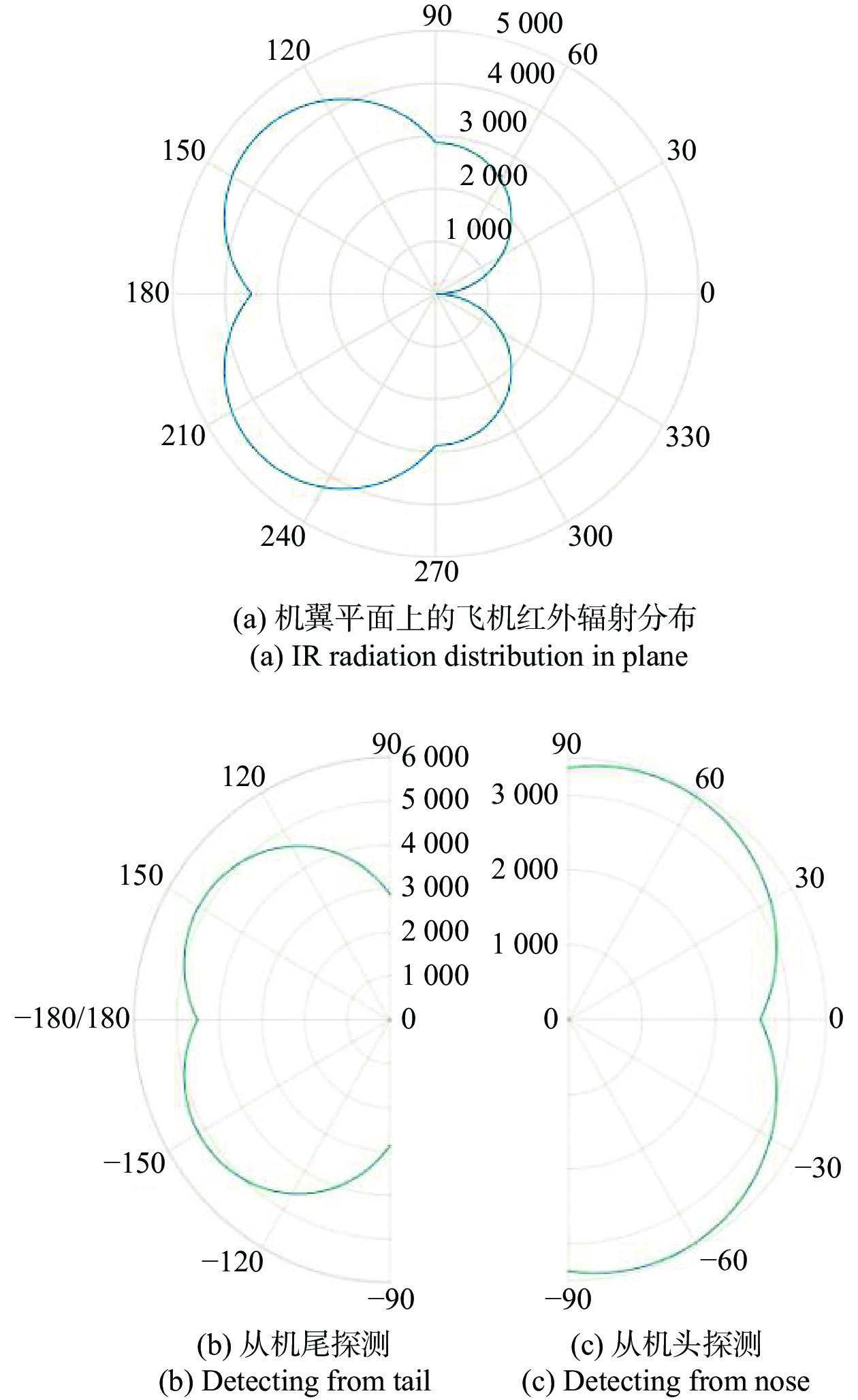-
建立如图1所示的机体坐标系计算飞机任意方向上的红外辐射[5]。平面1为飞机机翼平面,平面2为飞机纵向对称平面,平面1与平面2的交线为机轴,也是坐标系的X轴,机头方向为正。辐射方向与机轴的交点O为坐标原点,Y轴在平面2内且垂直于X轴。辐射方向OI在平面1投影OI1与X轴夹角为
$ \theta $ ,OI在平面2左侧为正,在平面2右侧为负。辐射方向OI在平面2投影OI2与X轴夹角为$ \gamma $ ,OI在平面1上方$ \gamma $ 为正,在平面1下方$ \gamma $ 为负。如果能够计算出在飞机机翼平面OI1方向上的红外辐射强度I1和在飞机纵向对称平面OI2方向上的红外辐射强度I2,则OI方向的红外辐射强度I为:
式中:
$ \alpha $ 为OI与OI1的夹角;$\; \beta $ 为OI与OI2的夹角。$ \alpha $ 和$\; \beta $ 由下式计算:设计算域的中心位于机翼平面OI1和飞机纵向对称平面OI2的交线上,与机头的距离为飞机长度的一半。计算域的长度为机长和尾焰长度2倍的和,宽度为机翼的宽度,高度为垂直尾翼高度的2倍[6]。
-
飞机的红外辐射包括尾焰红外辐射、尾喷管口红外辐射和气动加热的蒙皮红外辐射[7]。
-
尾焰可分为稳定区和混合区,如图2所示[8]。稳定区内温度恒定。稳定区向外直至尾焰边界为混合区,温度逐渐下降。设尾喷口直径为
${D_{\rm P}}$ ,混合区尾焰最宽处直径为${D_{\rm W}}$ ,稳定区的长为$ {L_1} $ ,尾喷口到混合区最宽处的长度为$ {L_2} $ 。将稳定区看为长轴为$ {L_1} $ ,短轴为${D_{\rm P}}/2$ 的半个长轴椭圆体,混合区看为长轴为$ {L_2} + {L_0} $ ,短轴为${D_{\rm W}}/2$ 的长轴椭圆体。图2中
$ {L_0} $ 为: -
(1)稳定区温度
稳定区温度[9-10]为尾焰在尾喷口处的温度。尾焰在尾喷口处的温度与尾喷口的温度有关,其计算公式为:
式中:
$ {T_2} $ 为尾焰在尾喷口处温度;$ {T_1} $ 为尾喷口温度;$ {P_2} $ 为膨胀后的气体压力;$ {P_1} $ 为尾喷口内的气体压力;$ \gamma_a $ 为气体的定压热容量和定容热容量之比。将混合区划分成若干个离心率相同的长轴椭圆体,如图3中的a1、a2、···、an。设a1、a2、···、an表面积分别为S1、S2、···、Sn,且认为椭圆体表面上温度相同,分别为T1、T2、···、Tn。a1、a2、···、an都不是完整的长轴椭圆体,需补充完整,如图中点状虚线所示。对于a1、a2、···、an,补全部分不完全一样,但其表面积相差不多。
设第n个长轴椭圆体表面距喷口的最远距离为
$ {l_n} $ ,则其短轴${{{D}}_n}$ 和表面积$ {S_n} $ 为:$ S' $ 为补全部分的表面积,其计算公式为:稳定区的表面积
$ {A_0} $ 为:设a1与稳定区的温差为
$ \Delta T $ ,an与an−1的温差为$ \Delta {T_n} $ ,则有:式中:
$ {T_n} $ 为第n个长轴椭圆体的表面温度。 -
稳定区在平面2上沿OI1方向的投影面积为[13]:
第n个长轴椭圆体在平面2上沿OI1方向的投影面积An为:
计算它们在平面1上沿OI2方向的投影面积时用
$ \omega $ 替代$ \theta $ ,后面类似情形同样处理。 -
尾喷口可看成灰体,其红外辐射与尾喷口温度
${{T}}_{\rm P}$ 和尾喷口直径有关。尾喷口在平面2上沿OI1方向的投影面积${A_{\rm P}}$ 为[14]: -
式中:
${T_{\rm s}}$ 为蒙皮温度;${T_{\rm a}}$ 为周围大气的温度;$ V $ 为飞机的速度。 -
设机体上方和下方蒙皮面积相等为
${A_{\rm u0}}$ ,机头方向蒙皮面积为${A_{\rm h0}}$ ,机体侧面蒙皮面积为${A_{\rm s0}}$ ,则机体上方和下方蒙皮在平面2上的投影面积和机体侧面在平面1上的投影面积为0。其中机头蒙皮在平面2上沿OI1方向的投影面积为:
机体侧面蒙皮在平面2上沿OI1方向的投影面积为:
机体上下蒙皮在平面1上沿OI2方向的投影面积为:
-
尾焰、尾喷口和蒙皮都可以认为是具有一定发射率的灰体,知道它们的发射率、辐射温度和有效辐射面积,就可以得到飞机的辐射强度为:
式中:
$ {\varepsilon _n} $ 、${{{A}}_n}$ 和$ {T_n} $ 分别为尾焰或蒙皮相应计算单元的红外发射率、有效辐射面积和温度;$ M(\lambda ,{T_n}) $ 为普朗克定律;${\varepsilon _{\rm P}}$ 为尾喷口的红外发射率;$ \mu $ 为尾焰对尾喷口红外辐射的衰减系数;$ r $ 为在辐射方向上尾喷口红外辐射在尾焰中的传输距离[16]。 -
根据上述模型计算了飞机3~5 μm波段、不同辐射方向上的红外辐射强度,如图4所示。仿真时所用参数主要根据某重型战斗机巡航时的红外图像选取,部分参数根据文献选取。具体为:
${D_{\rm P}}$ 取0.8 m、${D_{\rm W}}$ 取1.5 m、$ {L_1} $ 取1.2 m、$ {L_2} $ 取4 m、${{{T}}_1}$ 取800 K、$ \gamma $ 取1.3、P2/P1取0.5、$ V $ 取300 m/s、${T_{\rm a}}$ 取250 K、${A_{\rm u0}}$ 取106 m2、${A_{\rm s0}}$ 取33 m2、${A_{\rm h0}}$ 取8 m2、$ \mu $ 取0.15、蒙皮的发射率取0.5、尾喷口的发射率取0.9、尾焰的发射率取0.85[18-19]。 -
图4(a)为飞机3~5 μm波段红外辐射空间分布的三维图,图(b)~(e)分别为三维图的俯视图、侧视图、前视图和后视图。
由图4(a)可知,飞机的红外辐射关于机翼平面和飞机纵向对称平面对称。在机尾和机头各有4个强度相同的极值。根据仿真数据,分析得到机尾极值为5177 W,辐射方向为(
$ \pm $ 150o,$ \pm $ 32°)。前头极值为3461 W,辐射方向为($ \pm $ 68°,$ \pm $ 64°)。由图4(b)和(c)可知,飞机的红外辐射在水平面和纵平面的分布都呈鸭梨状,但在纵平面内分布更扁一些,原因是飞机上下表面蒙皮比侧表面蒙皮面积更大。
由图4(d)和(e)可知,在机尾正向和机头正向方向上,飞机的红外辐射比其邻近方向要小,特别是在机头正向上飞机的红外辐射极小。
从结果来看,仿真得出的飞机红外辐射空间分布曲线与参考文献[1]、[14]一致,均为鸭梨状。但参考文献[14]得出机体红外辐射极值为4500 W,略小于文中极值5177 W,其原因是文中研究机型为某重型飞机,红外辐射的强度与其他机型略有差异。依据参考文献[20]中提供的等效辐射方程,利用某重型战斗机巡航时的红外图像,反推出该战斗机在(145°,−17°)方向上的辐射为4230 W,仿真得到在该方向上的红外辐射为4 823 W,两者相差约为14%,其主要原因是建模时没有考虑不同部位蒙皮之间的遮蔽效应,特别是尾翼蒙皮对机体蒙皮的遮蔽。
-
根据仿真数据给出了
$ \gamma $ =0°全方位、$ \gamma $ =32°时机尾方向和$ \gamma $ =64°时机头方向红外辐射水平面的分布曲线,如图5(a)~(c)所示。其中给出$ \gamma $ =32°时机尾方向和$ \gamma $ =64°时机头方向红外辐射水平面分布曲线的原因是根据图4在这两个方向上存在极值。由图5(a)可知,在
$ \gamma $ =0°时飞机红外辐射水平面分布曲线呈鸭梨状,其极大值为4543 W,此时$ \theta $ 为$ \pm $ 138°。当$ \theta = {0} $ °时,即在机头正面时红外辐射极低,但当$ \theta \ne {0} $ °时红外辐射随着$ \theta $ 的增大急剧增加,其原因是当辐射方向偏离机轴时,飞机侧面蒙皮和尾焰有效辐射面积急剧增加。当$ \theta = {180} $ °时,在机尾方面红外辐射有最小值,为3493 W;且当$ \theta $ 偏离180°时,红外辐射会增加,但增加趋势不如机头方向。由图5(b)可知,在
$ \gamma $ =32°时,机尾红外辐射水平分布的极大值出现在$ \theta = \pm {150} $ °的方向上。可见随着$ \gamma $ 的变大,机尾红外辐射极大值的方向越靠近机轴。同样由图5(c)可知,在$ \gamma $ =64°时,机头红外辐射水平分布的极大值出现在$ \theta = \pm {68} $ °的方向上。而由5(a)可知,当$ \gamma $ =0°时,机头红外辐射极值方向为$ \theta = \pm {90} $ °,即当$ \gamma $ 变大时,机头红外辐射极大值出现的方向也越靠近机轴。 -
飞机红外辐射的纵平面分布如图6所示。图6(a)中曲线以
$ \gamma $ 为$ \pm $ 90°为分界线,右侧曲线对应的$ \theta $ =0°,左侧曲线对应的$ \theta $ =180°。图6(b)和图6(c)分别为$\theta = {150^ \circ}$ 和$\theta = {68^\circ}$ 时飞机红外辐射的纵平面分布曲线。由图6(a)可知飞机红外辐射纵平面分布曲线与其在水平面十分相似,其中
$ \gamma $ 为$ \pm $ 40°时,机尾方向极大值为4528 W。由图6(b)和图6(c)可知,当
$ \theta = {150} $ °时,机尾红外辐射纵平面分布的极大值出现在$ \gamma = \pm {32} $ °的方向上,当$ \theta = {68} $ °时机头红外辐射纵平面分布的极大值出现在$ \gamma = \pm {64} $ °的方向上,都呈现出在水平面上$ \theta $ 的方向越靠近机轴,则在纵平面上红外辐射出现极值的方向也越靠近机轴。 -
文中建立了一种尾焰红外辐射的椭圆体模型,计算得到了飞机3~5 μm波段红外辐射的空间分布曲线。计算结果表明:飞机红外辐射的空间分布关于机翼平面和飞机纵向对称面对称,且在机头和机尾方向各有4个极值。在机头正向红外辐射极低,但辐射方向一旦偏离机轴,红外辐射急剧增加。研究还发现:辐射方向在机翼平面(或机体纵向对称面)上的投影与机轴夹角越小,则在机体纵向对称面(或机翼平面)上红外辐射出现极值的方向越靠近机轴。
Simulation research on IR radiation space distribution characteristic of fight plane
doi: 10.3788/IRLA20220264
- Received Date: 2022-04-19
- Rev Recd Date: 2022-06-17
- Publish Date: 2023-01-18
-
Key words:
- infrared radiation /
- fight plane /
- ellipsoid modal /
- space distribution
Abstract: Considering the IR radiation space distribution research of fight plane is very little, in order to deeply understand IR radiation space distribution characteristics of fight plane in 3-5 μm, the infrared radiation ellipsoid model of tail flare is established, IR radiation characteristics of fight plane in different directions in 3-5 μm are simulated and calculated with the fight plane skin IR radiation model and the tail nozzle IR radiation model, and space distribution curves of IR radiation is given. The calculation shows that the infrared radiation of the aircraft is symmetrical with respect to the wing plane and the longitudinal symmetry plane of the fuselage. There are 4 extremes each in the tail and nose. The maximum value of infrared radiation is 5 177 W when the radiation direction is (



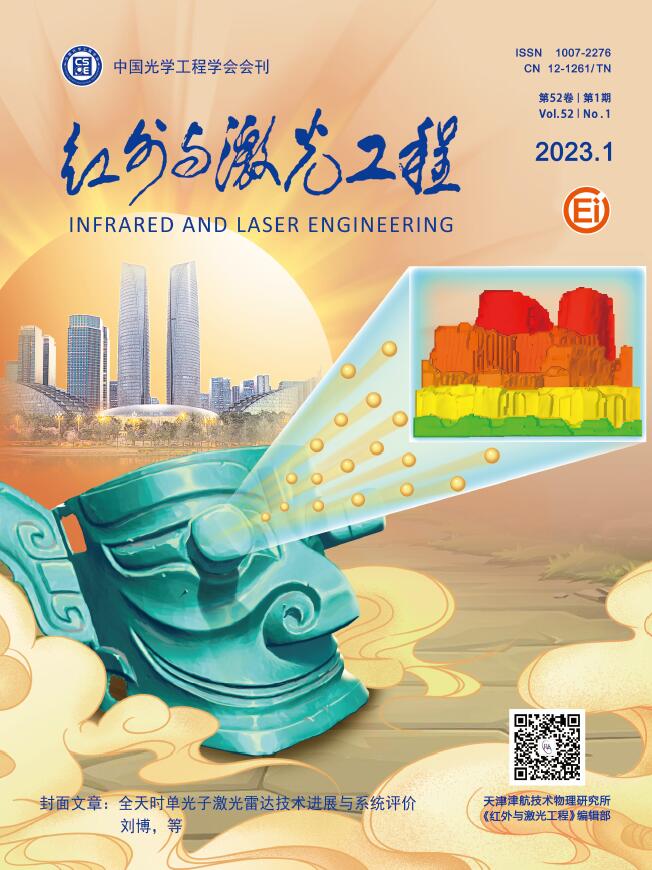



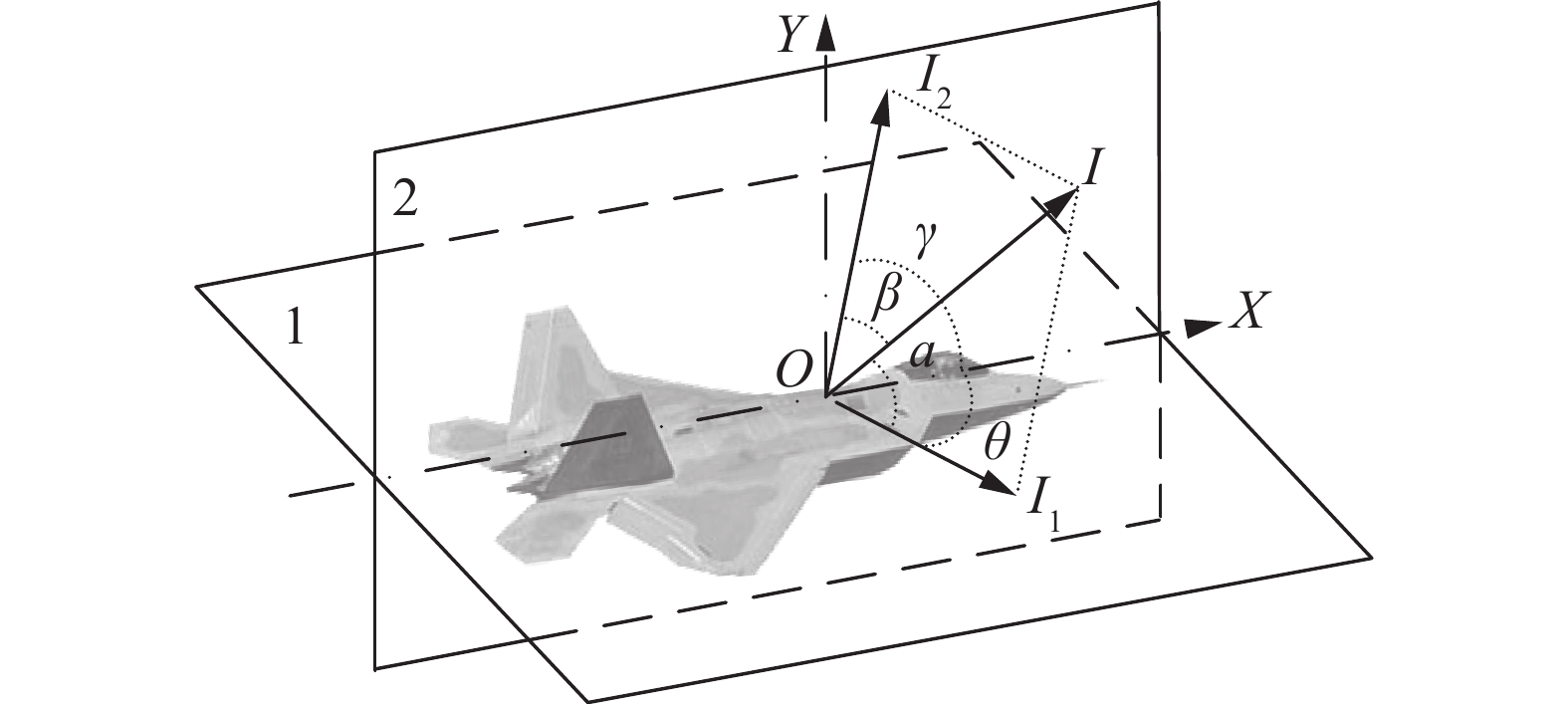






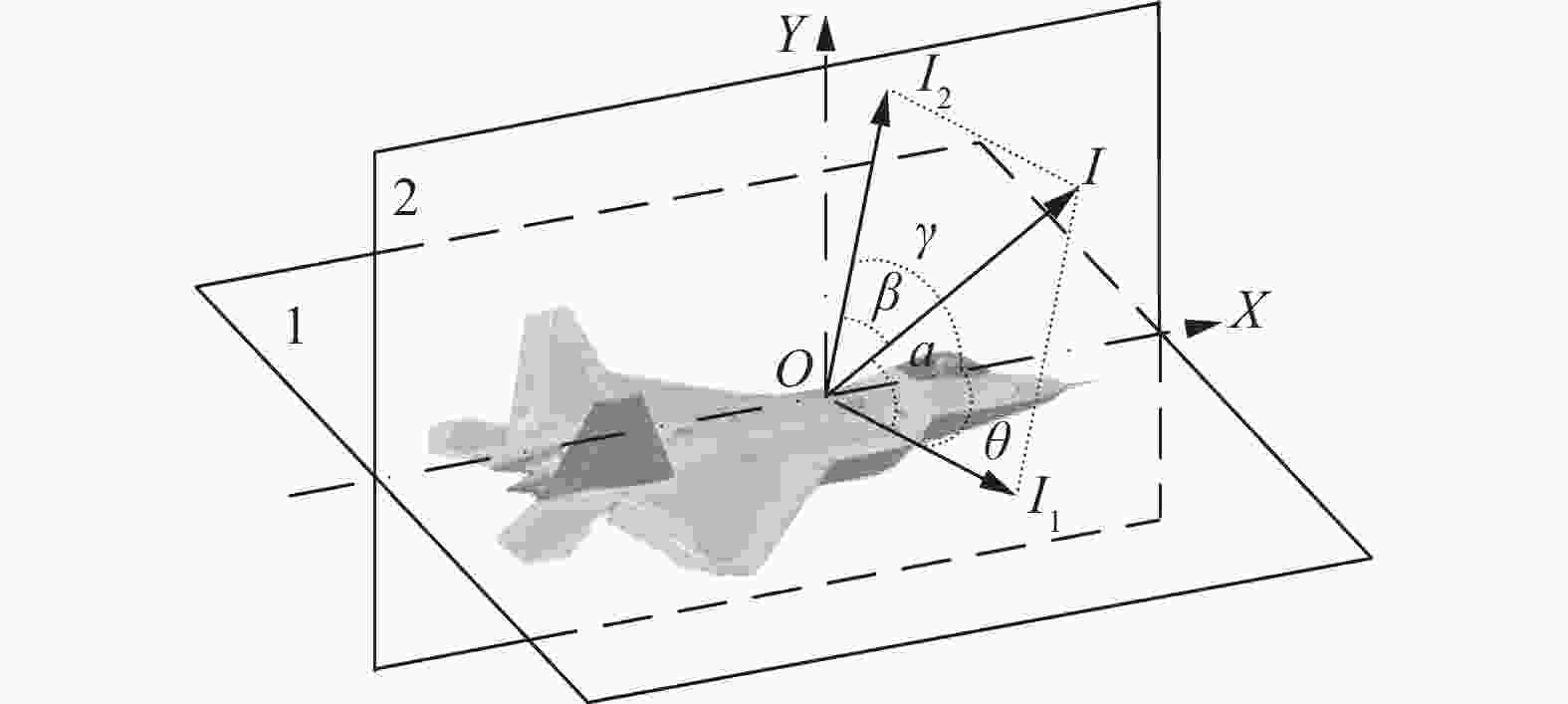



















































































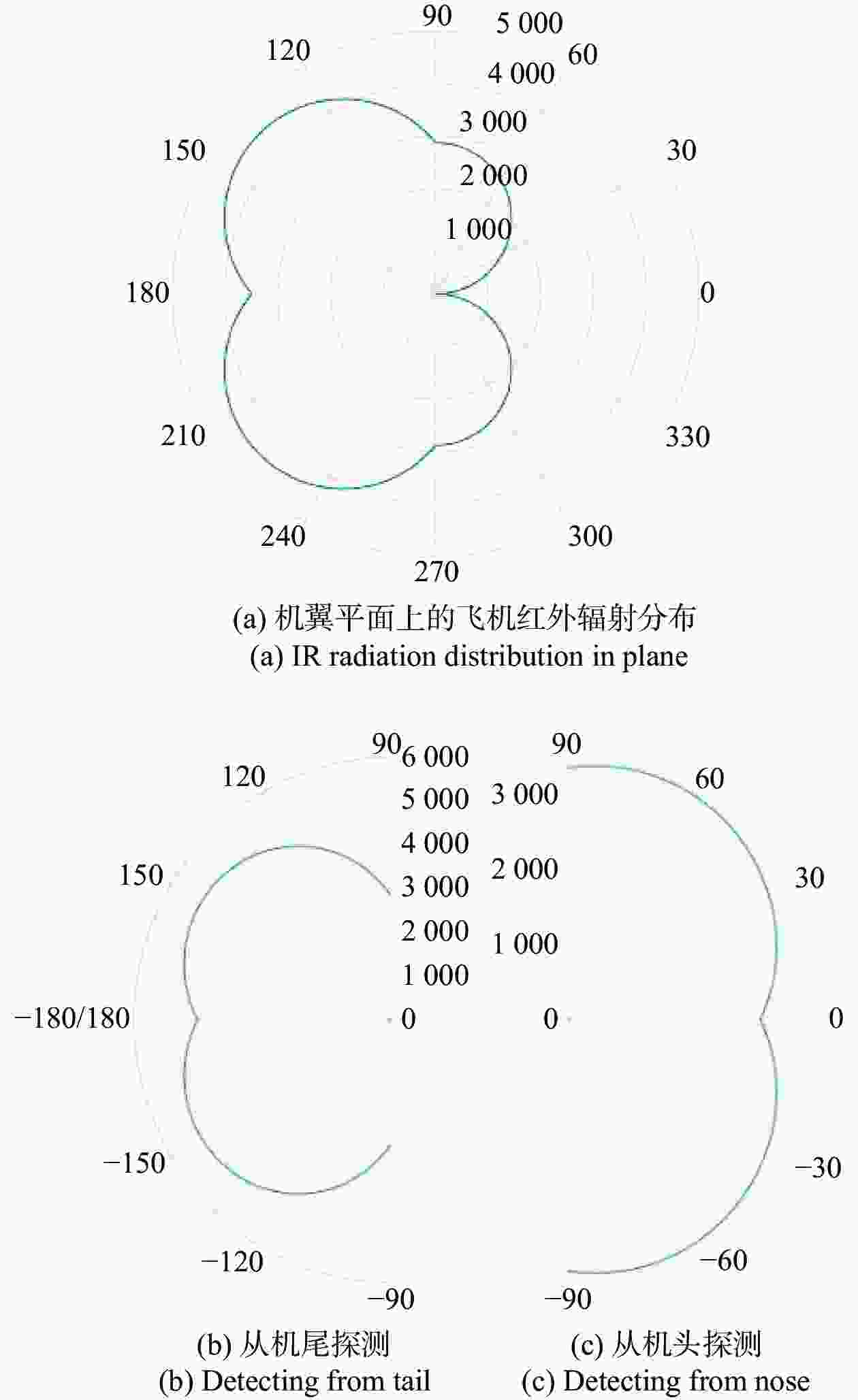















 DownLoad:
DownLoad:



